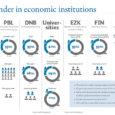Women in economics
There is good and there is bad news. First the good news of course. Explicit discrimination against women in the Netherlands is definitely something of the past. In our project, we did not encounter any rules prohibiting women from taking certain positions or managers stating that certain jobs are unsuitable for women.
Why is this ESB dossier in English?
The subject matter demands it. English is the main language of the economics and business faculties in the Netherlands, so an ESB dossier about the people who work there should be in English. Most of ESB’s publications tend to be in Dutch.
In fact, in a survey by Janneke Plantenga in this ESB special issue, all the deans of Dutch economics and business faculties indicate that they are actively trying to hire more female staff members and have the policies in place in order to do so. Moreover, they have provided ESB with the funds to put together this special issue offering insights from recent academic work into causes and solutions and putting it on the discipline’s agenda. Also, Jaap Schouten and Stan Gielen write about the many policies that are in place to improve the opportunities for women to receive funding from the Netherlands Organisation for Scientific Research (NWO), the most important public funding institute in the Netherlands.
A concerted effort
The bad news is that the environment in which research into economics and business takes place, is an environment in which women do less well than men. A cohort effect, in which the share of first-year female students or female PhD students a few decades ago is a good proxy for the share of female professors today, seems implausible. It appears that there still is a barrier for women trying to attain a professorial appointment. Van der Heijden (1993) reports that 25–30 years ago the share of female students was 25 percent on average and the share of female PhD students was 18 percent. The share of female professors in economics is currently 10 percent, as Teunissen and Hogendoorn mention in this issue and as the infographic shows.
This is bad news, and it requires all of us to take a firm stand on the issue. Changing an environment takes a concerted effort by everyone participating in it. Which seems even harder than addressing explicit discrimination.
The environment’s unforthcoming nature is hard to pinpoint. In his survey among Dutch economists, Harry van Dalen does not report a lot of significant differences between male and female academics except as to work pressure, while Ivo Arnold shows that female econometric students slightly outperform their male counterparts.
Economics and business stands out as particularly high in features that are generally perceived to be more masculine, like self-confidence and competitiveness, and low in traits that are generally regarded as more feminine, like cooperativeness and modesty. Instances of this have cropped up during the academics’ ‘the round table’, in the interview with Siv Gustafsson – one of the first female professors in economics in the Netherlands – as well as in Esther-Mirjam Sent’s column. Belle Derks, Ruth van Veelen and Michel Handgraaf also have ascertained this in their survey of Dutch academic culture. They find that here the biggest discrepancy is between the female economist’s self-reported masculinity and the reported masculinity they think is necessary for a successful career.
Mad men
That the culture within economics may be an issue might be hard to understand for economists who are trained to think in terms of market forces and the like. Perhaps a discussion of Figure 1 may help. The Rotterdam School of Management (RSM) recently adopted a new corporate branding and issued postcards to alert its staff members to the change.
I love the Mad Men theme of the postcards and the gleeful anticipation on the faces. I think the contrast in colour between the kitchen apron and the rest of the image works well. And I really think the ‘pun’ on huisstijl (branding) is funny.
It is also possible to regard this postcard as a typical white-male kind of humour that does not demonstrate inclusiveness as to women and/or other minorities. The man wears a tie, he works in an office – perhaps at the RSM – the woman wears an apron, and is probably cooking his meal. He is providing for her; he has his hands on her shoulders.
People who complain about these jokes are easily dismissed as being bad sports. But stereotypes definitely have an effect, just as role models do. They exclude and include respectively. Henriëtte Prast provides evidence pointing out how pervasive these stereotypes are in the economics education offered in high schools, Eline van der Heijden highlights their importance in academic careers, and Mirjam van Praag explains that she is happy to serve as a role model.

Next step
Much more can be done than merely addressing stereotypes. Anne-Wil Harzing, Claartje Vinkenburg and Marloes van Engen provide a comprehensive resumé of studies – published in peer-reviewed journals over the past two years – into various measures that departments can take. In addition, Anne Boring and Thomas Buser provide a motivation from behavioural economics for taking such measures.
It is possible that both the problem statement and its solutions are ignored, so careful treading is recommended. For example, Hein Schreuder points out that in more gender-equal societies fewer women choose to study science and technology, as women in these societies differ more from men (Stoet and Geary, 2018). And while it might be a good idea to ask women to participate more on search committees and as role models, the women that do so then lack the time to have careers themselves.
However, let’s be good sports. We economists have a market failure to fix.
References
Heijden, E. van der (1993) Vrouwen in de wetenschap. ESB, 78(3918).
Stoet, G. and D.C. Geary (2018) The gender-equality paradox in science, technology, engineering, and mathematics education. Psychological Science, 29(4), 581–593.
Auteur
Categorieën









